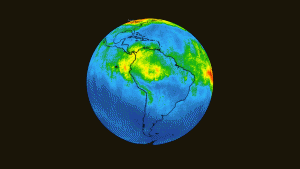 New data from NASA's Atmospheric Infrared Sounder (AIRS) instrument aboard the Aqua satellite shows the movement high in the atmosphere of carbon monoxide associated with fires in the Amazon region of Brazil.
New data from NASA's Atmospheric Infrared Sounder (AIRS) instrument aboard the Aqua satellite shows the movement high in the atmosphere of carbon monoxide associated with fires in the Amazon region of Brazil.
This time series maps carbon monoxide at an altitude of 18,000 feet (5,500 meters) from Aug. 8-22, 2019. As the series progresses, the carbon monoxide plume grows in the northwest Amazon region then drifts in a more concentrated plume toward the southeastern part of the country.
Each day in the series is made by averaging three days' worth of measurements, a technique used to eliminate data gaps. Green indicates concentrations of carbon monoxide at approximately 100 parts per billion by volume (ppbv); yellow, at about 120 ppbv; and dark red, at about 160 ppbv. Local values can be significantly higher.
A pollutant that can travel large distances, carbon monoxide can persist in the atmosphere for about a month. At the high altitude mapped in these images, the gas has little effect on the air we breathe; however, strong winds can carry it downward to where it can significantly impact air quality. Carbon monoxide plays a role in both air pollution and climate change.
Image Credit: NASA/JPL-Caltech

